#Lokeshvara
Explore tagged Tumblr posts
Text
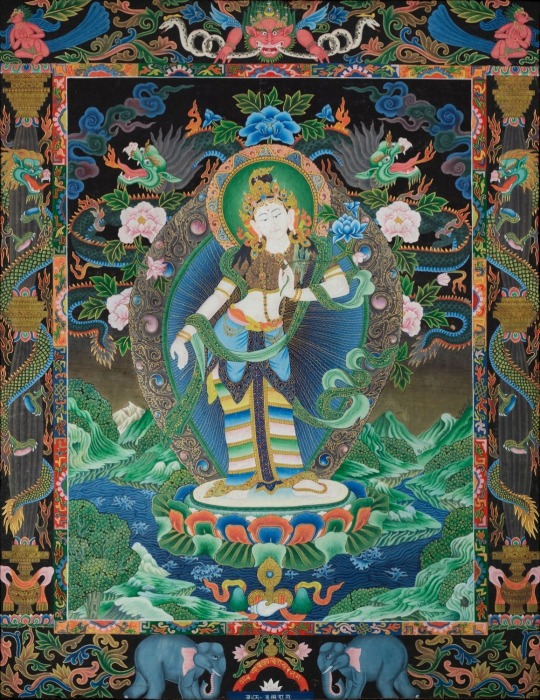
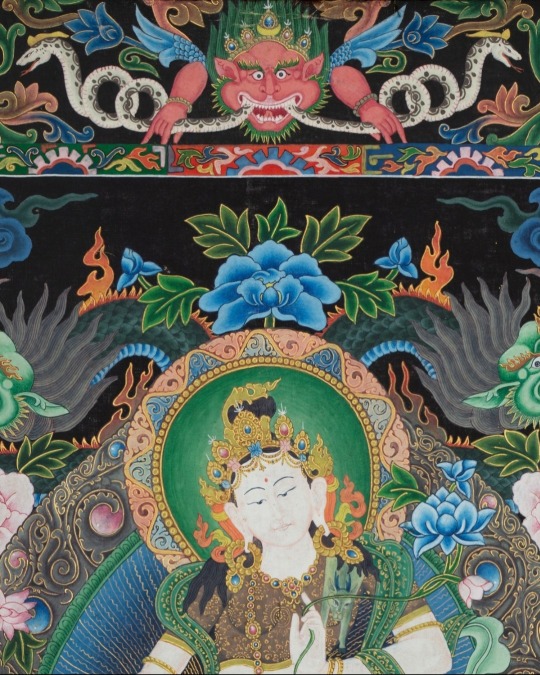
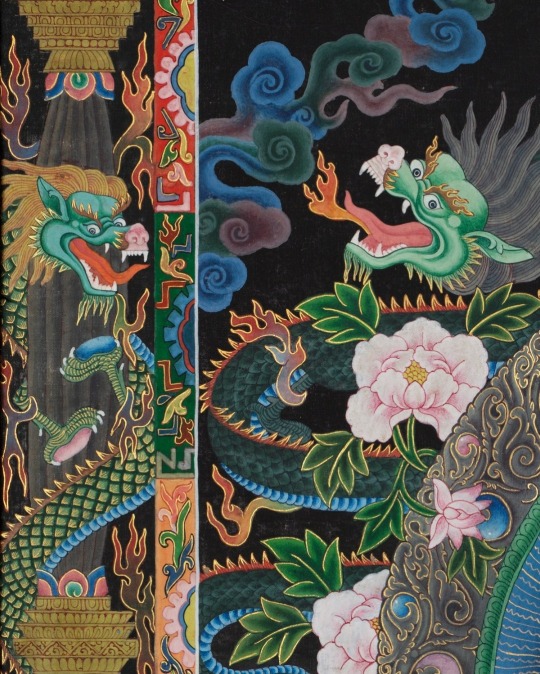

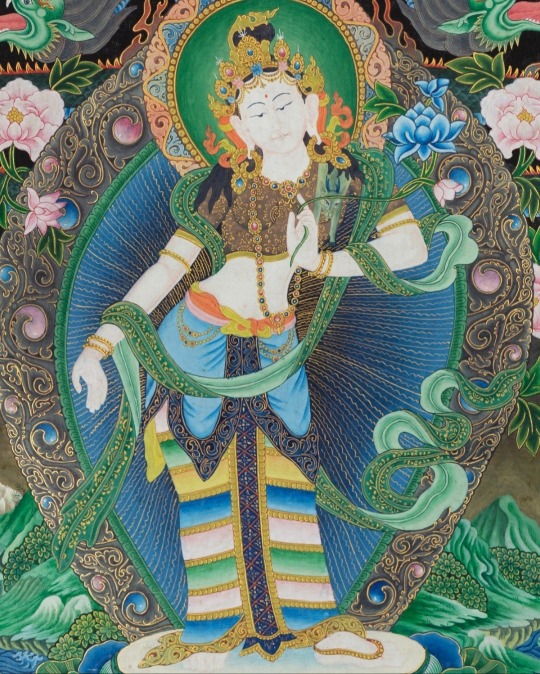
Newari Style Bodhisattva Padmapani Lokeshvara in 24 carat gold, gouache and acrylic colors on cotton canvas.
#no artist identification#buddhist art#newari#nepalese#thangka#buddhism#padmapani lokeshvara#bodhisattva
40 notes
·
View notes
Text

Avaloketishvara with the thousand arms / hands is one of the most known bodhisattvas.
In the vast realm of Mahayana Buddhism, Avalokiteshvara emerges as a beacon of compassion, a celestial figure celebrated across diverse cultures. This intricate exploration embarks on an odyssey through the layers of Avalokiteshvara's essence, unraveling the origins, various interpretations, and the profound symbolism encapsulated in the Thousand Arms manifestation.
Essence of Avalokiteshvara Avalokiteshvara, the compassionate Bodhisattva, embodies the very essence of Karuna—a boundless commitment to alleviating the suffering of all sentient beings. As we embark on this journey, envision Avalokiteshvara's form, standing as the earthly manifestation of the eternal Amitabha Buddha. His compassionate gaze spans the cosmos as he guards and protects the world during pivotal transitions, such as the departure of Lord Buddha and the anticipated appearance of the future Buddha, Maitreya.
Interpretations of Avalokiteshvara: The name "Avalokiteshvara" is not a mere label but a doorway to myriad interpretations. It resonates as "the lord who looks in every direction," reflecting his all-encompassing compassion. Yet, as we traverse cultural landscapes, his name transforms—becoming "Spyan-ras gzigs" in the lofty terrains of Tibet, "Nidü-ber üjegi" echoing in the vast Mongolian steppes, and "Lokeshvara," reverberating through the temples of Indochina and Thailand.
Origin in Mahayana Buddhism Within the embrace of Mahayana Buddhism, Avalokiteshvara emerges as a central figure—a Bodhisattva of profound significance. Dive into the core teachings as Avalokiteshvara, with unwavering resolve, vows to assist those in the throes of adversity. A pivotal decision unfolds as he postpones his own Buddhahood, choosing the arduous path of the Bodhisattva for the sake of sentient beings. The Mahayana Sutras, sacred scriptures revered in the Mahayana tradition, unfold a tapestry of wisdom surrounding Avalokiteshvara.
The Lotus Sutra (Saddharma Pundarika Sutra): Amidst the vast literature of Mahayana Buddhism, The Lotus Sutra emerges as a treasure trove of teachings. Avalokiteshvara takes center stage within its verses—a compassionate Bodhisattva, depicted with profound care for sentient beings.
Tibetan Tradition Avalokiteshvara's narrative takes on hues of mysticism and devotion in the highlands of Tibetan tradition. Delve into tales that weave dual origins—one from the heart of a compassionate monk and the other as the universal manifestation of the compassion of all Buddhas. Each story, a brushstroke on the canvas of Tibetan spirituality, adds layers to Avalokiteshvara's celestial portrait.
Thousand Arms Avalokiteshvara As we stand on the precipice of profound transformation, Avalokiteshvara's vow reverberates: "Should He Ever become disheartened in saving sentient beings, may his body shatter into a thousand pieces." Witness the symbolic metamorphosis as Avalokiteshvara becomes the Thousand Arms Bodhisattva—a visual symphony of overwhelming compassion and unwavering determination.
Symbolism and Miraculous Transformation: Marvel at the symbolism encapsulated in Avalokiteshvara's Thousand Arms and Heads. Amitabha Buddha, witness to the Bodhisattva's unwavering commitment, grants a divine intervention. Eleven shattered heads are replaced, not merely for aesthetics but as instruments to hear the cries and pleas of suffering beings. Thousand-fold arms unfold, not as a display of power but as a manifestation of compassion—reaching out to touch, heal, and uplift.
Mantras for Spiritual Connection In the sacred realm of spiritual practice, mantras serve as resonant chords connecting devotees with the divine. Here, we explore the melodic nuances of mantras associated with Avalokiteshvara, each a celestial invocation fostering a profound connection.
Notable Mantras:
O Mai Padme H: Within the cadence of this six-syllable mantra, Avalokiteshvara's compassion echoes through the chambers of Tibetan monasteries, a harmonious call to enlightenment.
Nama Saptn Samyaksabuddha Kon Tadyath o cale cule cunde svh: In the intricate brushstrokes of Shingon Buddhism, practitioners intone this mantra, unlocking layers of mystical significance.
On Arurikya Sowaka: The resonance of this mantra within the Shingon tradition unfolds like a sacred dance, each syllable invoking Avalokiteshvara's benevolent presence.
Namah Srimadavalokitesvaraya: Across the serene landscapes of Himal Pradesh, India, devotees chant this mantra, seeking solace in the compassionate embrace of Avalokiteshvara.
1000 Armed Chenrezig Avalokiteshvara Thangka
38 notes
·
View notes
Photo

Head of Lokeshvara. ca. second half of the 12th century. Credit line: Gift of Mary Kennedy, in memory of her mother, Josephine McMahon Kennedy and her brother, James J. Kennedy, 1978 https://www.metmuseum.org/art/collection/search/38550
#aesthetic#art#abstract art#art museum#art history#The Metropolitan Museum of Art#museum#museum photography#museum aesthetic#dark academia
12 notes
·
View notes
Text

Hayagriva, ritual mask
Hayagriva is a Great Protector (vidyaraja) and, together with Yamantaka, one of the most popular personal, tutelary deities (yidam) among the Gelugpa, particularly in Mongolia. It is a figure devotees could choose to identify with in their meditations (Yidam). Originally conceived as a form of the Hindu god Vishnu, Hayagriva was brought into the Buddhist pantheon in the sixth century as a manifestation of Avalokiteshvara, the Bodhisattva of Compassion, and a member of the Lotus Family of deities presided over by the Buddha Amitabha. His main role is as a destroyer of the obstacles standing in the way of enlightenment and as a Great Protector, particularly of the integrity of sacred texts.
Hayagriva is one of the very few yidams to assume a role as Great Protector in the 'tsam' ritual dance. The Mongolian tsam dances have an important artistical side. They include dances, musics and luxurious costumes, and have a didactic side since they represent a scenary or some persons from Buddhist philosophy. It's also supposed to bring good fortune to people. In the 19th century, more than 500 among the 700 monasteries of Mongolia had their own vision of the dance. Like Buddhas and bodhisattvas, the yidam were often generally ranked too high to appear in the dance. Although the nineteenth-century Russian Mongolist Aleksei Pozdneyev does not mention Hayagriva's participation in the Erleg Khan (Yama) tsam, Hayagriva did play a role in several different Tibetan performances, especially at Kumbum in Amdo. Similarly, in the tsam held as part of the ritual Mani Rimdu, Hayagriva has profound significance. Mani Rimdu's style was strongly influenced by Mindroling, a Nyingmapa monastery known for its elaborate dances using a hundred or more masks, whose head lama in the seventeenth century, Gyurme Dorje, was the guru of the broad-minded Fifth Dalai Lama. It was the Great Fifth who actively promoted the sacred dance among the Gelugpa and later influenced its development in Mongolia. In Mani Rimdu, which revolves around the figure of the Lord of the Dance (identified with Lokeshvara and Avalokiteshvara), Hayagriva is the "wisdom mind hero living inside Lokeshvara's heart" and is called on to perform a horse dance in which he "dissolves the three worlds into the objectless realm."
This large papier-mâché mask of Hayagriva depicts him in his role as one who expels demons and defines borders and who builds a Diamond Pavilion to keep out obstructive forces where devotees may dwell until Maitreya, the Future Buddha arrives.
13 notes
·
View notes
Text

In Mahayana Buddhism, we honor Amoghapasha Lokeshvara, depicted as a white, six-armed bodhisattva holding a noose and goad in each hand. The goad represents his skillful methods to expedite beings' enlightenment, while the noose symbolizes his compassionate approach. Practices such as visualization and mantra recitation are linked to Amoghapasha Lokeshvara, assisting practitioners in nurturing compassion and wisdom.
23 notes
·
View notes
Text
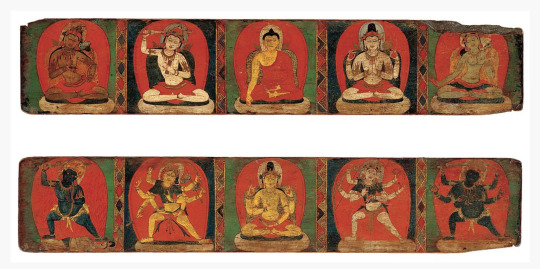
Pair of book covers with Buddhist deities. (Tibet, c. late 11th century).
The upper cover shows the most important Mahayana Buddhist deities: at center is the Buddha attaining enlightenment; at his right are the bodhisattvas Manjushri and Vajrapani; at his left sit Shadakshari Lokeshvara and Tara. Together, these deities represent enlightenment, compassion, correct method and practice; and protection from worldly harm. The lower cover, in contrast illustrates fierce protective deities flanking a central bodhisattva: Achala and Marichi at his right, and Mahapratisara and Mahakala on his left. Although these deities from the esoteric Vajrayana tradition appear in northern Indian sculptures and manuscript illustrations, only in Tibet are they grouped in a set as here.
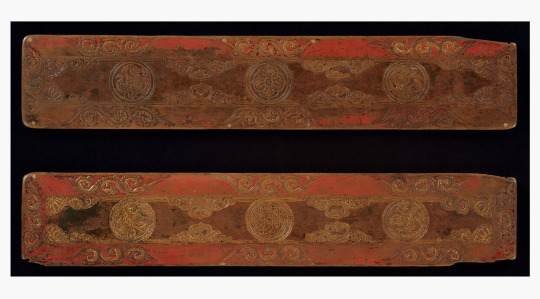
In the collection of the Metropolitan Museum of Art.
#beautiful books#book blog#books books books#book cover#books#incunabula#book design#book binding#tibetan buddhism
46 notes
·
View notes
Text

http://www.dharmasculpture.com/
Angkor King Jayavarman VII is depicted with his hair tied in a bun, engaged in deep meditation. Closed eyes, a smile illuminating his face: the serene expression of King Jayavarman evokes compassion. This is the face of a king who felt that the sufferings of his people were his own suffering and who built an extensive network of hospitals to take care of his people. A fervent Mahayana Buddhist, he placed Buddha and Lokeshvara at the top of a pantheon in which Hindu gods were also largely represented. He was king of the Khmer Empire in present day Siem Reap, the capital city of Siem Reap Province in northwestern Cambodia. It is the gateway to the Angkor region.
http://www.dharmasculpture.com/category/cambodian-buddha-statues.html
#angkorking#angkorkingjayavarman#kingjayavarman#kingjayavarmanvii#sereneexpression#buddhism#mahayanabuddhism#khmerempire#angkorregion#khmer art#cambodianart#buddhistart#dharmasculpture
2 notes
·
View notes
Text

Padmapani Lokeshvara, Java, lotussed edit.
5 notes
·
View notes
Text
Morning meditation — Symbols of Buddha's teaching, skill in teaching.
Morning meditation — Symbols of Buddha's teaching, skill in teaching. https://wp.me/pFy3u-7W9
‘Avalokitesvara or Simhanada (having the Lions roar) Lokeshvara. Sitting on a lotus on lion Symbols of Buddha’s teaching, skill in teaching.’ Diana St Ruth Bodhisattva Avalokiteshvara of the Lion’s Roar, or Simhanada Avalokiteshvara (Shi Hou Guanyin), late 15thearly 17th century China, On the net, of course, it’s morning, afternoon, evening, or nighttime 😀 somewhere. Click here to read more…

View On WordPress
4 notes
·
View notes
Photo

Shadakshari Lokeshvara Tibetan thangka Chenrezig 14X20 inch paper poster ebay wholesaledistributor888
0 notes
Photo




Bodhisattva - Swat Valley or Kashmir, 9th century
Kapoor Galleries Inc. wrote : The eight-armed bodhisattva with silver-inlaid eyes and pink copper lips dons an elaborate crown with a central petal resembling one side of a vajra. He is otherwise simply ornamented, seated in a meditative posture, holding a water pot in the lower proper-left hand and a blossoming lotus at his proper-left shoulder. He is likely a manifestation of the bodhisattva Lokesvhara, possibly Amoghapasha (the ‘Unfailing Lasso’).
The present figure comes from the Swat Valley in modern-day Pakistan. As the arts of Kashmir began to flourish under the Karkota Kings (600-855), who successfully ousted the Huns, the Swat Valley began to absorb their sophisticated bronze-casting tradition. This sculpture thus shares many qualities with Kashmiri examples such as the sophisticated metal inlay techniques and the style of the lion throne.
The throne style—a single row of lotus petals with an additional plinth supported by two front-facing lions around which a textile falls with tassels on either side—is one that became standard for the northwestern part of the Indian subcontinent for hundreds of years. The earliest iteration of this particular style in Pakistan is attributed by an inscription in Proto-Sarada to early-seventh-century Gilgit (Rubin Museum of Art, acc. C2005.37.2). The present figure, however, possesses other qualities that place it later in history.
While this figure was crafted in the Swat Valley or Kashmir, the small traces of blue polychromy at the hair and cold gold at the face and neck indicate that this bodhisattva made its way to Tibet, where painting bronzes is customary. Moreover, it is incised with the Tibetan number “3” at the back of the throne, indicating the position of the bronze within a larger set, perhaps along with the aforementioned Maitreya. (via Instagram: Kapoor Galleries Inc.)
47 notes
·
View notes
Photo

Magnificent clay images of Amoghpasha Lokesvara flanked by Arya Tara and Bhrikuti Tara enshrined at the side wing of Vasuccha Shil Mahavihar, Guita Bahi, Patan
20 notes
·
View notes
Photo

#neakpean “las #serpientes 🐍 #entrelazadas” es un #pequeño #templo 🙏🏻 ubicado en una #isla en el centro del ahora seco #Jayatataka #baray, un depósito de #agua de 3.500 metros de largo y 900 metros de ancho. Inicialmente dedicado al #Buda, el templo fue dedicado nuevamente a #Lokeshvara, el #Bodhisattva de la #compasión. Gran parte del área se #inunda durante la #temporada de #lluvia ☔ Una pasarela de #madera sobre las #aguas conduce al #santuario #central, que está #cercado para protegerlo de una mayor #descomposición. #cambodia🇰🇭 #nofilter #mirror (en Neak Pean) https://www.instagram.com/p/B2oagyXDlfj/?igshid=13nz0m603bv8f
#neakpean#serpientes#entrelazadas#pequeño#templo#isla#jayatataka#baray#agua#buda#lokeshvara#bodhisattva#compasión#inunda#temporada#lluvia#madera#aguas#santuario#central#cercado#descomposición#cambodia🇰🇭#nofilter#mirror
0 notes
Photo

~ Lokeshvara. Date: A.D. 13th–14th century Culture: Burmese Period: Pagan period or later Medium: Gray-green molded eartheware, possibly some carving.
84 notes
·
View notes
Photo

Happy Birthday to the 14th Dalai Lama, Tenzin Gyatso, who was born #OnThisDay in 1935.
As the spiritual leader of the Gelug School of Tibetan Buddhism, the Dalai Lama is understood to be an earthly manifestation of the Bodhisattva Avalokiteshvara (A.K.A. Lokeshvara, Chenrezik, Guanyin, and Kannon). All Bodhisattvas are compassionate role models, guiding Buddhists toward enlightenment, but Avalokiteshvara is the very personification of compassion.
Several graceful, gentle images of Avalokiteshvara appear in our newly-opened Arts of Buddhism and Arts of the Himalayas galleries on the second floor of the Museum.
📷️ Seated Bodhisattva Lokeshvara, 10th century. Bronze, 5 1/2 x 4 1/4 x 3 in. (14 x 10.8 x 7.6 cm). Brooklyn Museum, Purchased with funds given by Mr. and Mrs. Richard Shields, 72.55. Creative Commons-BY
34 notes
·
View notes
Text

Chintamani Lokeshvara, Bejeweled Plaque, Nepal, 19th Century CE. sapphire, emerald, coral, ruby, spinel, topaz, beryl, onyx, turquoise, lapis lazuli, malachite, amethyst, beryl, rose quartz, ivory in a gold and copper inlay. CSMVS museum, Mumbai, India.
3 notes
·
View notes